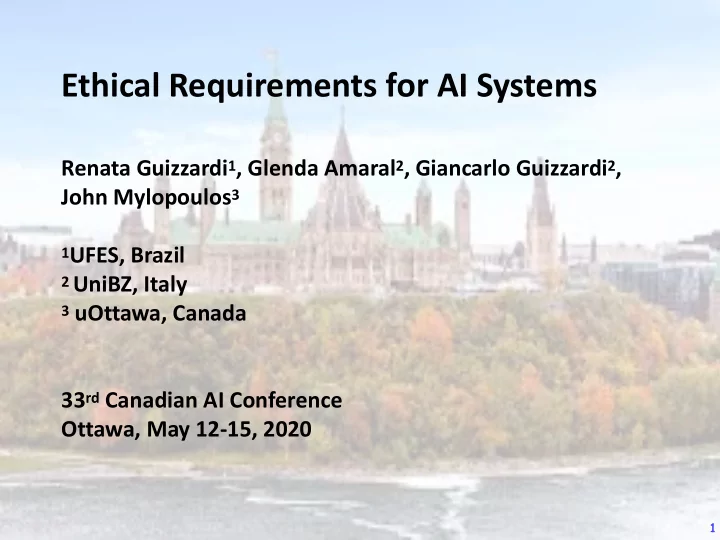

Ethical Requirements for AI Systems Renata Guizzardi 1 , Glenda Amaral 2 , Giancarlo Guizzardi 2 , John Mylopoulos 3 1 UFES, Brazil 2 UniBZ, Italy 3 uOttawa, Canada 33 rd Canadian AI Conference Ottawa, May 12-15, 2020 1
AI systems must abide to ethical principles AI systems are being built today that drive cars, make diagnostic decisions, or fight military battles. Such systems are performing tasks that require human judgment and need to abide with ethical principles and codes. Such codes exist for professional drivers, for medical doctors, and for the military. We propose that such codes can serve as sources for deriving ethical requirements for AI systems using requirements engineering techniques. 2
Requirements Engineering (RE) Part of Software Engineering (SE) concerned with the elicitation and analysis of stakeholder requirements to derive a specification for a system-to-be. Specifications consist of functions the system-to-be must be able to perform, quality constraints and domain assumptions. Stakeholders include all parties that are affected by the system-to-be, or influence the development or the operation of the system Ethical requirements are elements of a specification (functions, quality constraints, domain assumptions) derived from ethical principles or codes. 3
Ethical principles and codes Ethical principles are general principles of conduct towards others. For example, the European Union has adopted the following ethical principles for AI systems: ✓ Autonomy -- respect for human dignity, ✓ Beneficience -- doing good to others, ✓ Nonmaleficence -- doing no harm to others, ✓ Justice -- treating others fairly, ✓ Explicability -- behaving transparently towards others. Ethical codes are domain-specific codes of conduct derived from ethical principles; such codes exist for all professional activities, such as for employees of an organization, medical doctors, public transit drivers, or for the Canadian military. 4
Ethical Req’nts as Ecological Req’nts Traditional RE often limits stakeholders to just users of the system to-be. In AI system, this needs to be extended to other parties For example, for a driverless car, this would include pedestrians, passengers, other drivers, by standards, etc. Ethical Requirements are necessarily Ecological Requirements , in the sense that they are necessarily derived from the whole ecosystem in which the design system is included. From an ontological point of view, this is the case because they are derived from an analysis of value and risk , which are themselves contextual properties (dependent on the context for their manifestations). 5
Applying RE to derive ethical req’ents Step I: Identify stakeholder types in the operational environment of the system-to-be. ✓ For a driverless car, this should include passengers, pedestrians, drivers of nearby cars, bikers, etc. Step II: For each stakeholder type and each ethical principle, derive stakeholder requirements the system-to- be should fulfill. For a driverless car: ✓ the car shouldn’t drive too close to a biker ( nonmaleficience ); ✓ the car should not send personal information about a pedestrian ( autonomy , more specifically privacy ); ✓ the car should allow another car to cut in front of it ( beneficience ); ✓ the car should be able to explain what route it is going to use to get to its destination and why ( explicability ) 6
Derive ethical req’ents (cont’d) Step III: For each requirement identified in step II, derive ethical requirements, i.e., functions, quality constraints, or domain assumptions that are to be included in the specification of the system-to-be. For a driverless car, consider ✓ “don’t drive too close to a biker” : system-to-be should support a function for recognizing bikers the system is driving by, also its DRIVE function must be constrained to maintain a distance of 0.75m from any such biker. ✓ “should not send personal information about a pedestrian” : specification shouldn’t include any sending-of personal- information functions; ✓ “ should allow another car to cut in front of it ”: specification should include a recognition function for cars that are trying to cut into the lane of the system-to-be, also a function for making space for them. 7
Derive ethical req’ents (cont’d) ✓ Step III: For a driverless car, consider (cont’d): ✓ “ should be able to explain to its passengers what route it is going to use to get to its destination and why ”: specification shall include an explanation function that can generate explanations such as “we are taking route A because traffic on the alternative route B is moving very slowly” 8
Discussion In this position paper, we propose to adopt RE techniques to build AI systems that comply with ethical principles and codes. We illustrate our proposal with the derivation of functions and quality constraints from ethical principles for a driverless car. It is important to emphasize that our solution doesn’t render an AI system autonomous in ethical decision-making. Rather, it results in systems that comply to ethical principles by design . As for implementing ethical requirements, the system-to-be should be able to perform any such functions as well as humans, e.g., recognizing a passed-by biker, or making space for another car to cut in front. 9
Recommend
More recommend